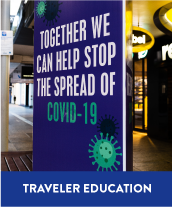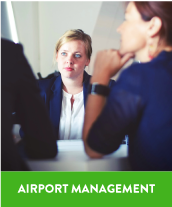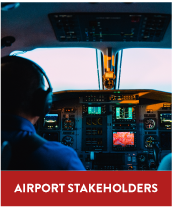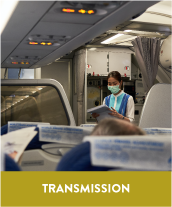Mitigation Measures: Guide
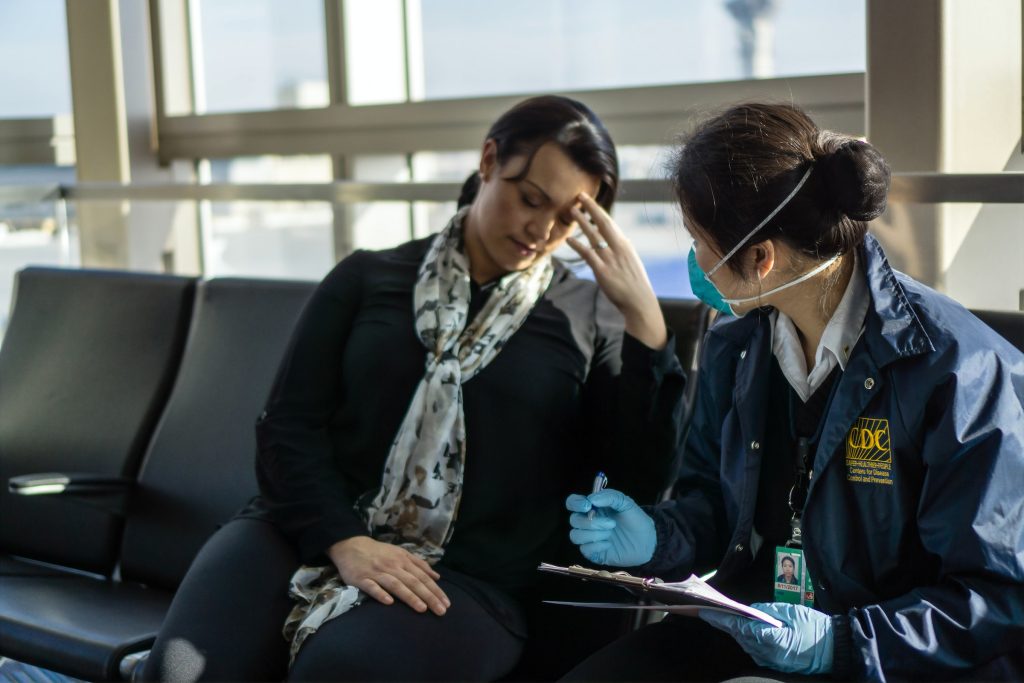
Cleaning and Disinfection Protocols
High-Touch Areas
Increasing the disinfection frequency of high-touch areas such as door handles, light switches, restroom stall latches, chairs, and tables helps reduce the spread of communicable diseases. Performing risk matching by identifying areas of elevated risk and exposure was crucial for janitorial teams to ensure time and resources were being utilized effectively. Most airports interviewed had their janitorial staff and even their operations staff assigned to disinfect kiosks. Some airports kept their handrails for escalators and moving walkways clean by using handrail cleaning systems. These systems use pads that disinfect the belt as it moves. One airport implemented nightly disinfection of all gate seating and screening locations. Cleaning products were assigned to each station with different colored microfiber towels assigned to different areas (e.g., green for public areas and red for restrooms). Dirty towels were replaced every night so as employees came in, they could use the clean towels to wipe down their respective areas. Sanitization of the restrooms was repeated at 30 to 45-minute intervals.
Cleaning Products
Many airports spent significant amounts of time and money on products without knowing their true effectiveness, and in some cases suffered side effects such as surface damage and deterioration as a result. This made the disinfecting processes inefficient and sometimes ineffective. One airport found that some of the disinfecting wipes they used left a white film over the chairs after a certain period. These also clogged up the plumbing system due to passengers throwing them in the toilet. However, multiple airlines utilized these products to increase the comfort and sense of trust with their customers.
Disinfectants
Different cleaning products require different contact times for disinfection to be achieved. According to the Environmental Protection Agency (EPA) List N tool of COVID-19 disinfectants, many of these products required long contact times. As of September 2024, there are currently no EPA-registered anti-viral coating products that have long-lasting efficacy against communicable diseases. Therefore, airports and airlines cannot rely on such products to disinfect screens for their kiosks, increasing the expenses for resources and staff to routinely keep these clean. Some airports shared that their Communicable Disease Response Plans (CDRP) included disinfectants that are EPA-registered and considered hospital grade, such as Diversey-Virex® II 256, Ecolab-Multi Surface Peroxide Cleaner/Disinfectant, and Spartan-BNC-15, that were used to disinfect surfaces.
Microfiber Towels
The use of microfiber towels was helpful in preventing the spread of communicable diseases through contact with physical surfaces. Microfiber towels work well for removing organic matter and germs from surfaces. A study done with microfiber cloths investigated whether they are effective in reducing the level of microorganisms associated with healthcare infections and found they were an effective way to reduce the levels of E. coli, methicillin-resistant S. aureus, and the spore form of C. difficile on a range of surfaces found in the clinical environment.2 As such, airports should consider utilizing microfiber cloths as part of their cleaning and disinfecting protocols.
Employee Health Screening Policies
Employee Contact Tracing
When one employee tested positive for SARS-CoV-2, it was important for airports to perform contact tracing to understand which additional employees could potentially be at risk of contracting the virus. Maintaining the confidentiality of the infected and exposed employees is essential. Some airports only informed exposed individuals that they had been exposed to the virus and were then given further advice on quarantine and isolation requirements. Much of the contact tracing was conducted by looking through the infected employee’s schedule to identify who had been exposed during the same shift, or by gathering information from the infected employee. Airports should include contact tracing procedures in their CDRP.
Hygiene Policies
Hand Sanitizer
Hand sanitizers were one of the most common tools used to maintain personal hygiene. Multiple airports identified high-risk areas for contracting the virus and installed hundreds of hand sanitizer stations. Some high-risk areas identified were airline check-in and ticketing counters, Transportation Security Administration (TSA) security screening checkpoints, bathroom entrances/exits, and gate seating areas. Other airports installed wireless hand sanitizer stations that were tracked wirelessly to notify the cleaning facilities when they were empty. Incorporating this kind of mitigation policy into steady-state operations may simplify operations during a public health incident.
Indoor Air Quality Policies
Air Filtering
High-efficiency particulate air (HEPA) filters are a type of pleated mechanical air filter that can remove at least 99.97% of dust, pollen, mold, bacteria, and any airborne particles with a size of 0.3 microns. Purchasing air HEPA filter devices and utilizing filters with the the highest rated minimum efficiency reporting values (MERV) (i.e., MERV 16–20) at the airport is one way to reduce the spread of a virus and improve air quality within the airport. A study done by Harvard University showed that most airports already had various types of air filters in their heating, ventilation, and air conditioning (HVAC) systems before the COVID-19 pandemic started, and several upgraded the filter efficiency in their systems to those with a higher MERV in response.1 HVAC systems are also equipped with filtration systems to block larger particles from entering the air space. To ensure the highest air quality within the airport, the American Society of Heating, Refrigerating, and Air-Conditioning Engineers standards should be followed. The Center for Disease Control and Prevention (CDC) also developed “The Clean Air in Buildings Challenge” which highlights recommendations and resources available for improving ventilation and indoor air quality, which can help to better protect the health of building occupants and reduce the risk of COVID-19 spread. Key actions outlined in the CDC Clean Air in Buildings challenge included creating a clean indoor air action plan, optimizing fresh air ventilation.
Social Distancing
Passengers
Different methods were used to encourage passengers to maintain social distance. Airlines implemented the blocking of their middle seats to separate passengers and some airports went as far as removing every other seat at gate areas to promote social distancing.
Employees
Some airports found the best way to maintain social distancing for airport employees was to identify the minimum number of employees in each department required to meet critical business needs and request the rest work from home. They could then manage staff based on ongoing or changing business needs, increasing hours as needed, or bringing back additional staff when necessary. If there was not an immediate business need, teams could continue to telework offsite. Some airports returned staff in phases using two-week increments to effectively monitor for illnesses and viral spread. Having staggered shifts ensured that not all employees were at the facility at once while still allowing the airport to cover essential operations. For essential workers, some airports moved meetings and shift briefs to a virtual setting. Other airports took advantage of spaces where equipment was stored to create mini-break rooms for employees, providing crews with separate places to rest so that they were not confined to one communal area. Some changed their shifts to four 10-hour days with hybrid schedules and created clustered work groups to stop the overlapping of employees.
Social Distancing Protocols
Airports undertook significant efforts to encourage and enable social distancing during COVID-19 operations. It was widely understood that implementing physical barriers such as transparent plastic shields in high-risk areas where employees have close interactions with multiple customers, such as TSA security checkpoints, can help mitigate the spread of the virus. Social distancing for employees and tenants, as well as customers, was managed through both messaging and physical reminders (such as markings on the ground) and barriers. Many airports restricted the number of people that could process through checkpoints at a given time to prevent crowding. Approaches to social distancing and the impacts it can have on airport facilities and policies, as well as on staff planning, should be considered in future communicable disease planning efforts.
[1] Faculty and Scientists at the Harvard T.H. Chan School of Public Health. (2022). Assessment of Risks of SARS-COV-2 Transmission and Non-Pharmaceutical Interventions to Reduce Risk. Retrieved September 14, 2022, from https://www.hsph.harvard.edu/wp-content/uploads/sites/2644/2022/09/Harvard-APHI-Phase-Two-Report.pdf
Banner image credit: Unsplash
